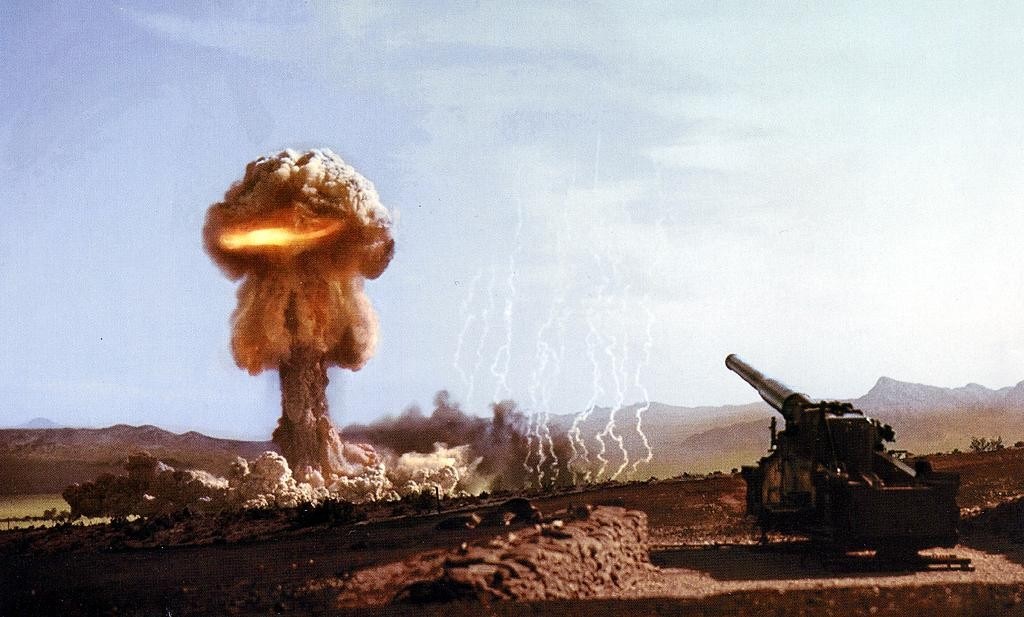

The commander of the U.S. military’s nuclear forces recently acknowledged that no one knows if using low-yield or tactical nuclear weapons will trigger a full-scale nuclear war.
Ever since the Cold War, commanders have considered whether it is possible to conduct a limited nuclear war. That’s why the United States developed “tactical nuclear weapons,” which were originally conceived to be used against specific troops and installations instead of completely destroying the other side.
In May 1953, the Army tested “Atomic Annie,” a cannon that could fire a shell with a 15-20 kiloton nuclear warhead up to 20 miles. It quickly became obsolete and was withdrawn from service in the 1960s.
Other tactical nuclear weapons were meant to be carried by U.S. troops behind enemy lines, such as the B-54 Special Atomic Demolition Munition, which could fit in a backpack. (Special Forces soldiers were required to stay within visual range of the target to make sure the bomb actually went off.)
First produced in 1968, B61 nuclear gravity bombs continue to be in the U.S. military’s arsenal. They are being updated with GPS so they can function more as smart bombs.
Under former President George W. Bush, the Defense Department looked into whether bunker busting bombs could be fitted with nuclear warheads, but in 2005 Congress killed funding for the Robust Nuclear Earth Penetrator. (Although the Energy Department was considering using a bomb with a 1-megaton warhead, so this bunker buster could have been considered a strategic weapon.)
More recently, the Navy in February fielded the W76-2, a low-yield nuclear warhead for submarine-launched ballistic missiles. This is likely the new secret nuclear weapons system that President Donald Trump bragged about when talking to author Bob Woodward for the book Rage, although he could have been referring to the planned W93 warhead.
The return to the idea of limited nuclear war is relatively recent. At the moment, the U.S. military feels that it needs relatively small nuclear weapons to prevent potential adversaries – particularly Russia – from using any of its own low-yield nuclear weapons in the belief that they can escape U.S. retaliation.
One scenario envisioned by the Trump administration in the 2018 Nuclear Posture Review is that Russia could use tactical nuclear weapons at the very start of a war because they believe the United States would not launch its intercontinental ballistic missiles or use other strategic nuclear weapons in response.In other words, if the Russkies have baby nukes and we only have big nukes, Ivan might exploit the baby nuke gap as part of their unscrupulous doctrine of “Escalating to De-escalate.”
If this sounds a little nutty to you, please keep in mind that the military has had far wackier ideas in the past. In 1994, the Air Force proposed building a bomb that would make enemy troops so “sexually irresistible” to each other that they would focus on the physical act of love instead of fighting, a weirdly offensive weapon dubbed the “gay bomb” at the time.
While the United States has leaned into tactical nukes in recent years, the Russians have made clear that they would view any nuclear attack as the start of a war, regardless whether the U.S. uses a tactical or strategic nuclear weapon.
“Those who like to theorize about the flexibility of American nuclear potential must understand that in line with the Russian military doctrine such actions are seen as warranting retaliatory use of nuclear weapons by Russia,” said Russian Foreign Ministry spokeswoman Maria Zakharova in April.
The debate over ‘tactical’ nukes, it seems, is a matter of semantics. Even former Defense Secretary James Mattis, who has supported developing nuclear-tipped cruise missiles, told Congress that the word “tactical” is not applicable when describing nukes.
“I don’t think there is any such thing as a ‘tactical nuclear weapon,’” Mattis told Congress in February 2018. “Any nuclear weapon used any time is a strategic game-changer.”
Since both sides seem to agree that once the button is pushed there is no running away, the W76-2 seems kind of useless. It’s not as if Vladimir Putin would say: “Those clever Americans have used a ‘tactical’ nuclear weapon. Now my hands are completely tied!”
When Navy Adm. Chas Richard, the head of U.S. Strategic Command, came to the Pentagon on Sept. 14, Task & Purpose asked if he believed the United States could actually use the W76-2 against Russia or China and escape a full retaliation.
Richard said the W76-2 is meant to deter anyone else from using low-yield nuclear weapons in the first place so that the United States doesn’t get into a nuclear exchange with another country. When Task & Purpose asked Richard if a nuclear war could be confined to low-yield weapons – and if tactical nuclear weapons even exist – the admiral’s answer was both brutally honest and slightly terrifying.
“The answer is nobody knows if that’s the case,” Richard replied. “But I do think it’s an obligation for the United States to do everything in its power should a nuclear weapon be used by somebody else to stop the exchange as soon as possible, to limit damage to the U.S. to the maximum extent possible, and to end it on terms favorable to the United States.”
“The short answer to your question is, is that nobody knows,” he continued. “Fortunately we don’t have any real-world experience in that, and I would just as soon keep it that way.”
Not getting the Pentagon Run-Down? Sign up here!
Jeff Schogol covers the Pentagon for Task & Purpose. He has covered the military for 15 years and embedded with U.S. troops in Iraq and Haiti. Prior to joining T&P, he covered the Marine Corps and Air Force at Military Times. Comments or thoughts to share? Send them to Jeff Schogol via email at schogol@taskandpurpose.com or direct message @JeffSchogol on Twitter.
